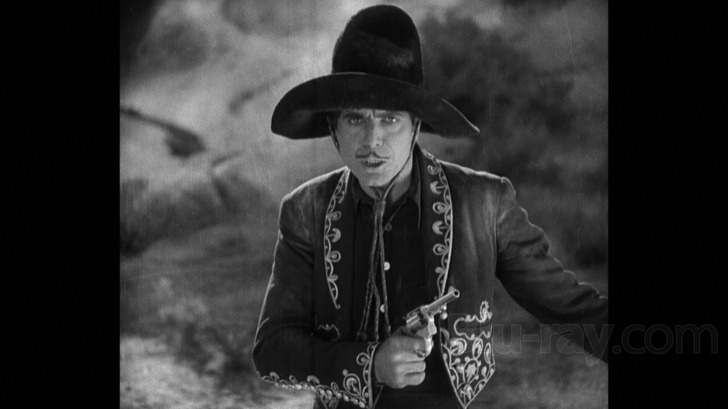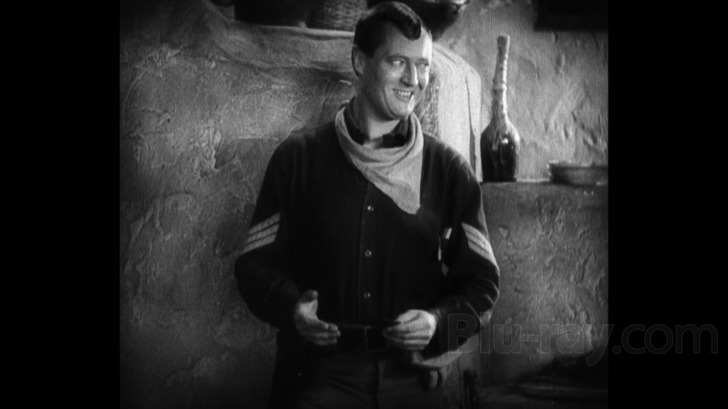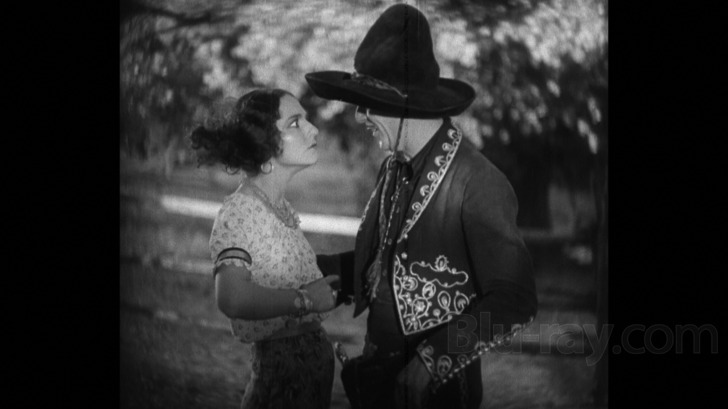In Old Arizona Blu-ray Movie
HomeIn Old Arizona Blu-ray Movie 
Fox Studio Classics20th Century Fox | 1928 | 99 min | Not rated | Jun 04, 2013
Movie rating
6 | / 10 |
Blu-ray rating
| Users | 4.5 | |
| Reviewer | 2.5 | |
| Overall | 2.5 |
Overview
In Old Arizona (1928)
A charming, happy-go-lucky bandit in old Arizona plays cat-and-mouse with the soldier trying to catch him while he romances a local beauty.
Starring: Warner Baxter, Edmund Lowe, Dorothy Burgess, Henry Armetta, Alphonse EthierDirector: Irving Cummings, Raoul Walsh
| Romance | Uncertain |
| Western | Uncertain |
Specifications
Video
Video codec: MPEG-4 AVC
Video resolution: 1080p
Aspect ratio: 1.19:1
Original aspect ratio: 1.2:1
Audio
English: DTS-HD Master Audio Mono
English: Dolby Digital Mono
Subtitles
English SDH, Spanish
Discs
25GB Blu-ray Disc
Single disc (1 BD)
Playback
Region free
Review
Rating summary
| Movie | 2.5 | |
| Video | 2.5 | |
| Audio | 2.5 | |
| Extras | 0.0 | |
| Overall | 2.5 |
In Old Arizona Blu-ray Movie Review
Return with us now to the less than thrilling films of yesteryear.
Reviewed by Jeffrey Kauffman August 22, 2013Modern technology has gotten to the point where seemingly anything a filmmaker can dream about can be fairly easily translated into “reality”, if by reality we mean the digitally processed imaginary world of the screen. We’ve come so far so quickly that it’s hard to really remember (if indeed any who are old enough to remember are still with us) when the mere fact of watching images move was considered a technical marvel of incredible proportions. That ostensible miracle was perhaps only matched once in the entire history of film, when the era of synchronized sound began in 1927 and the “talkies” were born (and for you sticklers for historical accuracy, yes, there were efforts in sound going back to almost the dawn of commercial film exhibition prior to the famous debut of The Jazz Singer). But in an indication of how quickly the film industry didn’t just accept new technologies, but actually embraced them, pushing them to new horizons, just a little more than a year after The Jazz Singer premiered in October 1927, Fox did the unthinkable: they made a sound film on location. Outside. In Utah. In Old Arizona, like many an older film, hasn’t aged particularly well, but it’s historically important for the reasons listed above, as well as for the fact that it earned star Warner Baxter an Academy Award as Best Actor and for the fact that according to some sources it exploited an even newer sound technology, becoming the first film to place the soundtrack directly on the film rather than the patented Warner Vitaphone approach which played synchronized discs timed to deliver the sound as the film was projected. The film is therefore probably best appreciated as something of a curio, one whose intrinsic archaic qualities will probably diminish actual viewing enjoyment, but whose place in the annals of film, and especially film technology, must be appreciated and even lauded.

The Cisco Kid has had a rather long and intriguing history in several different media, to the point that few are even aware anymore that the character actually was the brainchild of O. Henry, who introduced a rather vicious criminal in “The Caballero’s Way”. There were actually a couple of silent films featuring the character before In Old Arizona rather radically rethought the character and posited him as a sort of lovable rascal who “never steals from individuals”, but who instead aims for lockboxes full of gold that are being transported by stagecoaches across the scenic west.
As historically important as In Old Arizona undoubtedly is, it’s probably the long running Cisco Kid series from the thirties and forties that most permanently disseminated the character to the public at large. Warner Baxter in fact appeared in the first of these quickies, but soon a parade of other actors, including future television Batman joker Cesar Romero, took over the role. Duncan Renaldo also essayed the part in several of the films and became forever associated with the role when he starred in the long running television series which became an early favorite of then young Baby Boomers in the very earliest days of the medium.
That fact may have relegated Warner Baxter to mere footnote status in the long history of The Cisco Kid, but it’s instructive to note that as florid as his performance is, it’s probably the single greatest asset In Old Arizona has. Baxter has a sort of devil may care ambience about him, with a definite twinkle in his eye as he romances women and evades the attempts to capture him, including by Sergeant Mickey Dunn (Edmund Lowe), a kind of literal minded soldier who is too stupid to realize he’s actually in the same room with the criminal in one relatively early scene.
In Old Arizona does do one kind of unexpected thing. In a film of this era and of this general temperament, one would expect the hero (which in this case is the putative “bad” guy, The Cisco Kid) to have a steadfast romantic partner, and indeed The Kid has Tonia Maria (Dorothy Burgess), to whom he sings a rapturous love song penned by the notable team of DeSylva, Brown and Henderson. But here Tonia is shown as something of a two faced lover, ultimately hooking up with Dunn with the thought that she can collect the sizable reward that’s been posted for The Kid’s capture.
The film’s most notable element other than Baxter’s mostly enjoyable performance is no doubt the rather beautiful location photography that makes the most of several southern Utah locations, locations that later became iconic when John Ford started using them years after co-directors and Raoul Walsh and Irving Cummins did in this film. Common wisdom states that Walsh himself was supposed to star in this film but had to withdraw after being seriously injured on a drive from Utah to California when a rabbit actually catapulted through his car windshield and ended up causing Walsh to lose one of his eyes (Walsh became famous for the eye patch he wore for the rest of his life). While some aspects of this story are in dispute (notably as to whether or not Walsh was actually supposed to play The Kid), his direction, or at least supervision (since it’s not entirely clear how much he may have been involved after his injury), delivers a fairly cohesive story that probably thrilled audiences in its day, but which in retrospect seems slightly encrusted with formaldehyde. Still, there’s no denying the audacious technical achievement In Old Arizona represents, and for that reason alone it should probably be seen by everyone with an interest in film history.
In Old Arizona Blu-ray Movie, Video Quality 

In Old Arizona is presented on Blu-ray courtesy of 20th Century Fox Home Entertainment with an AVC encoded 1080p transfer in 1.19:1. This is one of those films where it's absolutely mandatory to understand history and the vagaries of time to reasonably assess what this high definition presentation looks like. It's evident that original elements were not available for this transfer (many early Fox film elements were destroyed), and we are dealing with an at times quite badly damaged secondary element. This means that virtually the entire image is littered with pretty bad (and sometimes annoyingly constant) scratches and print through as well other associated damage. The occasional frame is missing as well, and there is repeated warping in evidence as well. The look here is often extremely soft and rather heavily coated with grain. There are also noticeable contrast variances throughout the film, which in some cases are rapid enough to create a kind of quasi-flicker. And so, that sounds like this should be horrible, right? Well, not so much—or at least not as much as might be expected from the above run down. The image is reasonably stable (aside from the anomalies listed above) and while fine detail is only middling at best, it's certainly head and shoulders above previous versions of this film I've seen through the years. The film is obviously such a curio and of such limited general appeal that the cost of full scale restoration would no doubt have been prohibitively expensive. What's here is fairly problematic quite a bit of the time, but it's certainly watchable and better than might be expected.
In Old Arizona Blu-ray Movie, Audio Quality 

Well, this is a first, and some audiophiles are no doubt going to be asking themselves, "What's he been smoking?" As with the previous DVD release, this Blu-ray offers a "restored" mono track, here delivered via DTS-HD Master Audio, as well as what is called the "historical" original mono track in Dolby Digital. Call me crazy (get in line, please), but I'm actually more inclined to recommend the lossy Dolby track. For all its warts, which include manifold pops, cracks and even the occasional dropout or two, it's quite a bit more audible than the "restored" track, which, for all its lossless allure, sounds weirdly strangulated, especially in the upper registers, in what I would (perhaps ironically) call an audio analog to the much derided "digital noise reduction". Fidelity is middling at best, as befits this very early talkie, with an extremely narrow ambience and a brittle, unappealingly flat sound most of the time.
In Old Arizona Blu-ray Movie, Overall Score and Recommendation 
In Old Arizona is one of those films that film theory teachers love to foist off on their students, knowing that the film may bore everyone to tears but that there will still be things to discuss in class the next day. Without trying to sound overly didactic, I have to agree with those professors who may actually admit that this film doesn't have a ton of redeeming entertainment value for modern day audiences, but who insist the film's technical achievement override any of those concerns. That said, this high definition presentation simply hasn't been able to work much magic with extremely problematic elements.
Similar titles
Similar titles you might also like

The Outlaw
1943

3 Bad Men
1926

The Broadway Melody
Warner Archive Collection
1929

The Heiress
1949

Duel in the Sun
Roadshow Edition
1946

Rio Bravo
1959

Third Person
2013

Brooklyn
2015

The Furies
1950

Disobedience
2017

September
1987

Two Lovers
2008

Last Night
2010

The Great Man's Lady
1942

God's Little Acre
1958

From the Terrace
Limited Edition to 3000
1960

Great Day in the Morning
Warner Archive Collection
1956

The Fugitive Kind
1960

Tootsie
1982

Vicky Cristina Barcelona
2008
